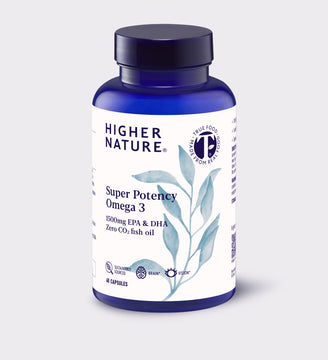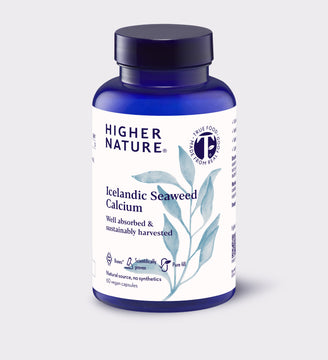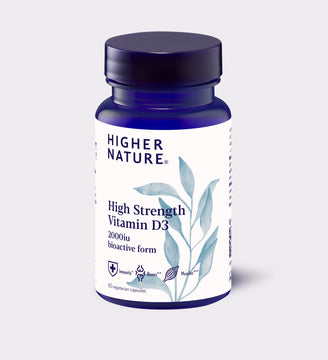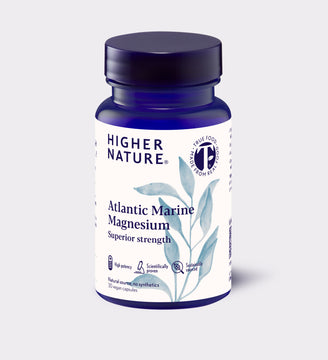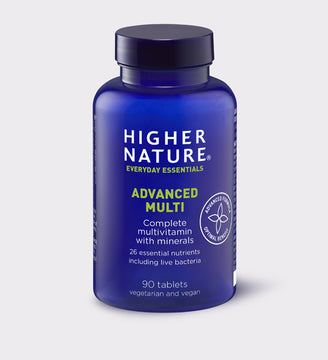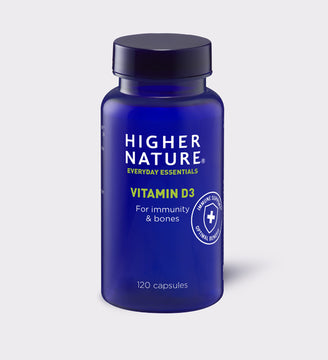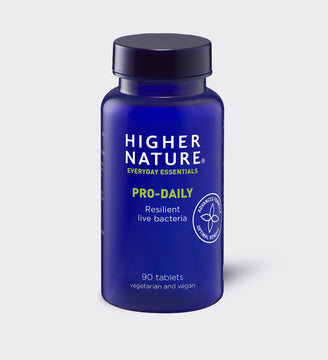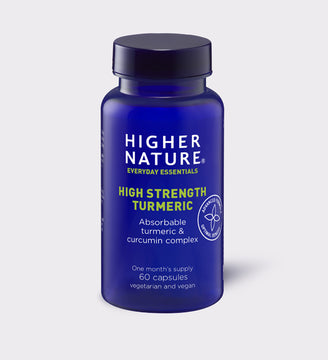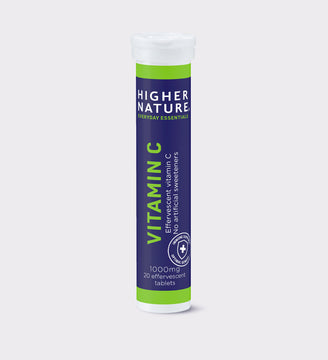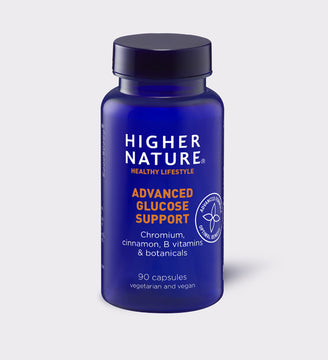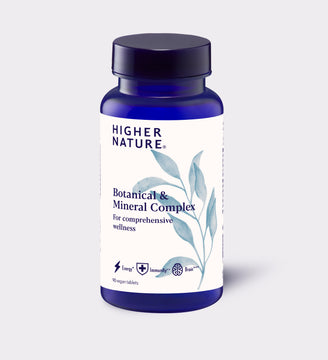
Do you have high blood pressure?
Higher Nature Nutrition Team
Are you one of the 1 in 4 people worldwide with high blood pressure? Because high blood pressure (hypertension) rarely causes any symptoms, it is estimated that some 5.5 million people in England alone have undiagnosed high blood pressure.
Even without any symptoms, high blood pressure can cause damage to your blood vessels and heart over many years and is a major risk factor for heart disease, possibly leading to a stroke or heart attack if not well controlled.
How is blood pressure measured?
Blood pressure is determined by the amount of blood your heart pumps and the amount of resistance to the blood flow in your arteries. The more blood your heart pumps and the narrower your arteries, the higher your blood pressure.
The blood pressure reading is expressed by two numbers - for example - 120/80. These are measured in millimetres of mercury - mmHg.
The systolic blood pressure is the highest number and reflects the force that blood exerts on arteries with each heartbeat.
The lower number is the diastolic pressure- that is, the lowest level the blood pressure reaches in between beats when the heart is relaxed.
What is the normal range?
A healthy blood pressure for adults will be in the range of 90/60 to 120/80 mmHg
High blood pressure is considered to be 140/90mmHg or higher.
Low blood pressure is considered to be 90/60mmHg or lower.
If your blood pressure is consistently between 120/80mmHg and 140/90mmHg, alarm bells should be sounding as you may be at risk of developing high blood pressure unless you take steps to keep it under control. But don’t panic after just one high blood pressure reading – take multiple readings over time and if you have consistently high blood pressure readings, you will need to work on lowering your blood pressure.
Are there any symptoms at all?
Noticeable symptoms of high blood pressure are rare, which is a major problem, as if left unchecked, blood pressure may reach a very high level and lead to the following:
- Dizziness
- Nosebleeds
- Shortness of breath
- Chest pain
- Blurred vision
- Headaches
However, you can keep an eye on your blood pressure by having it checked during routine medical examinations or by using a blood pressure monitor at home.
Who is more at risk of high blood pressure?
These are the main risk factors for developing high blood pressure:
- being overweight or obese
- being over the age of 65
- being of African or Caribbean descent
- having a relative with high blood pressure
- poor diet with too much salt and low intake of fruit and vegetables
- not taking sufficient physical exercise
- drinking too much alcohol or caffeinated drinks
- smoking
- chronic stress and mental health issues
- getting insufficient sleep or having disturbed sleep
Take back control!
It goes without saying that reducing stress levels, losing weight, stopping smoking and increasing physical activity will all help you to take control of your blood pressure.
You may also need to take steps to improve your diet including reducing salt intake, reducing alcohol and caffeinated drinks and increasing fruit and vegetable consumption. Known to be one of the healthiest diets, the Mediterranean diet which is rich in fruits, nuts, vegetables, legumes, olive oil, oily fish, and is low in meat and dairy, is associated with maintaining healthy blood pressure.
Now, lets take a look at some specific foods that can help your blood pressure………..
Fabulous foods for healthy blood pressure include:
Garlic - used as a spice, a food, and for a variety of health issues over 5,000 years, garlic has long been recommended for its cardiovascular benefits. More recently, research has reported the benefits of garlic for supporting healthy blood pressure. The active ingredient in garlic – allicin - is also present in onions, shallots, leeks, chives and spring onions, so try to use plenty of these in your cooking and salads. Crush or chop the garlic as finely as possible to release the maximum amount of allicin. Using garlic in place of salt is an excellent way to flavour foods and support your cardiovascular system.
Oily fish – the omega 3 fats found in oily fish such as mackerel, salmon, sardines and herring are thought to support healthy blood pressure through the relaxation of blood vessels, so promoting more efficient blood circulation. Fish oils are rich in the omega 3 fatty acids EPA and DHA which contribute to the maintenance of normal blood pressure.
Beetroot - trials have shown this “superfood” to play an important role in lowering blood pressure. It turns out that the benefits of beetroot are down to the nitrate it contains, which is turned into nitric oxide in the body, causing the blood vessels to dilate and lowering blood pressure.
Nitrate is also present in other vegetables including celery, watercress, rocket and spinach, however it is best to eat these vegetables raw to keep the nitrate intact. Processing and cooking can reduce nitrate content. Boiling beetroot or spinach will inevitably lose some of the nitrate in the water, however, if you use these veggies to make soup, the nitrate lost in the water will remain in the soup. Steaming is the best method of cooking as it uses less water and so less nitrate will be lost.
Another way to get your beetroot fix is to juice it raw and combine with juiced apple, celery and a little ginger.
Tart cherries - tart cherry juice has been shown in trials to significantly lower blood pressure. Specifically, participants in one study who drank tart cherry juice made from U.S. grown Montmorency tart cherries experienced a significant reduction in systolic blood pressure as well as in low-density lipoprotein (LDL) or "bad" cholesterol. Researchers linked the resveratrol content of the cherries to the drop in blood pressure.
Berries - raspberries, strawberries and especially blueberries are not only delicious but packed with plant antioxidants called anthocyanins which are great for your blood pressure. Studies have shown that eating just one cup of strawberries or blueberries each week can reduce the risk of developing high blood pressure. It is thought that the antioxidant pigment resveratrol, also found in cherries, is significant in helping to produce more nitric oxide to dilate the blood vessels.
Apples - follow the old adage “an apple a day keeps the doctor away” and you won’t go far wrong! High in fibre and low on the glycaemic index, apples also provide the flavonoid, quercetin, which is thought to help support healthy blood pressure.
Dark Chocolate - for some people, we may have saved the best till last! Dark chocolate contains compounds called flavanols which are believed to play a role in the production of nitric oxide in the body. As we have seen, nitric oxide widens blood vessels and promotes the healthy flow of blood, thus reducing blood pressure. Dark chocolate also contains magnesium which relaxes blood vessels. So choose a dark chocolate with a high percentage of cocoa solids (70% or more) and eat in moderation, ideally combined with a handful of unsalted nuts such as almonds, pistachios, Brazils, and cashews. which are also rich in magnesium!
Natural nutrient solutions
Please note: If you are diagnosed with high blood pressure you may be prescribed one or more medications and it is dangerous to stop your medication without discussing this with your medical practitioner.
If your blood pressure is only slightly high, alongside the other dietary and lifestyle measures outlined above, you might consider taking supplements such as co-enzyme Q10, garlic, magnesium and omega 3 fish oils:
There is also some small scale evidence to suggest that the bioflavonoid, quercetin, may be helpful in lowering blood pressure. An analysis of small clinical studies has shown that taking quercetin 500-1000 mg daily for 4-10 weeks decreased systolic blood pressure by 3.04 mmHg and diastolic blood pressure by 2.63 mmHg compared with placebo.
If using nutritional supplements, we advise regular monitoring of your blood pressure to assess the effects.
